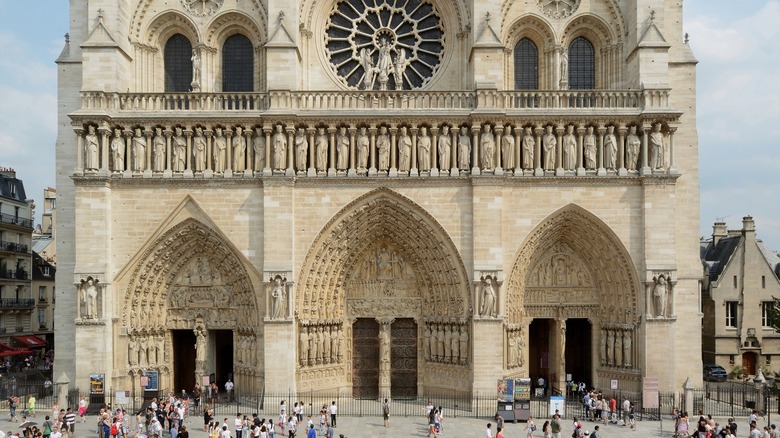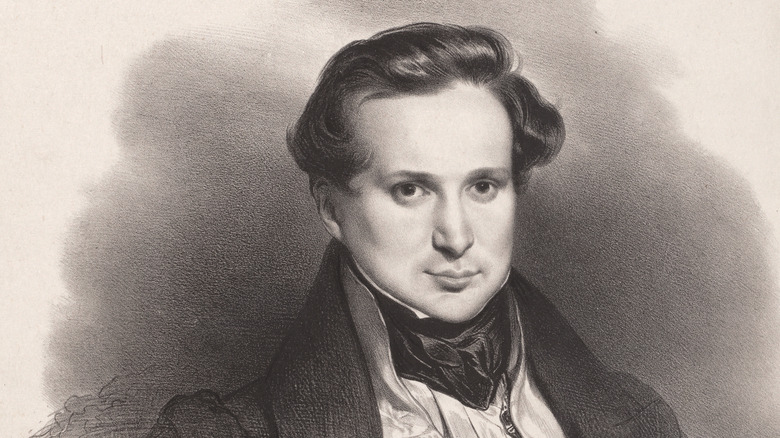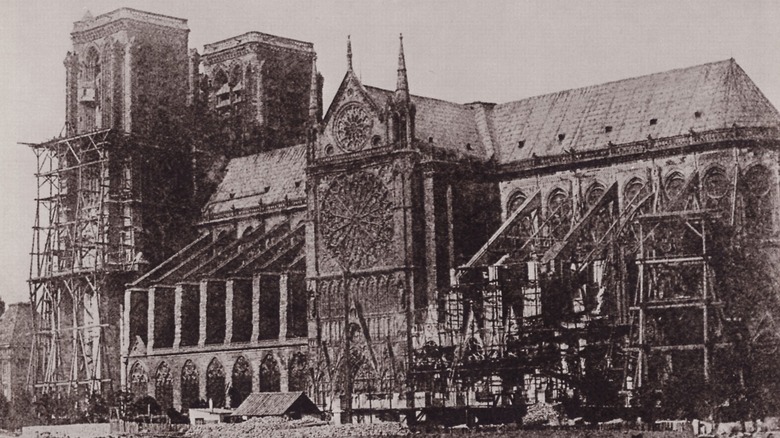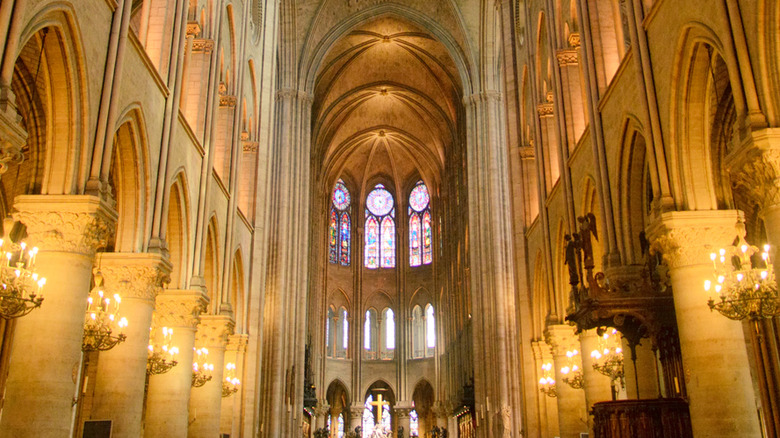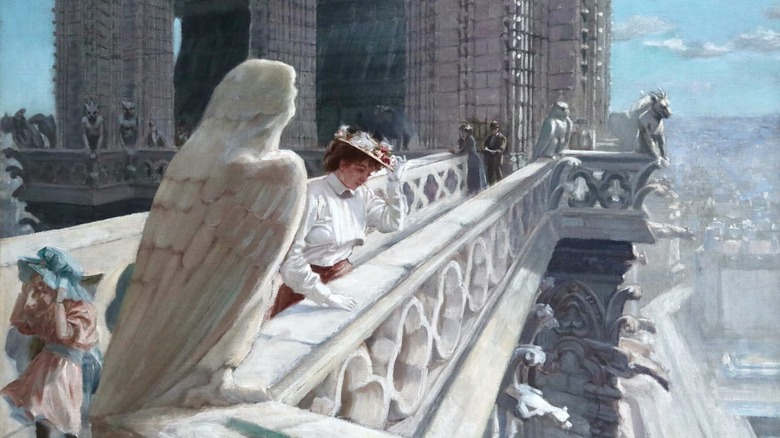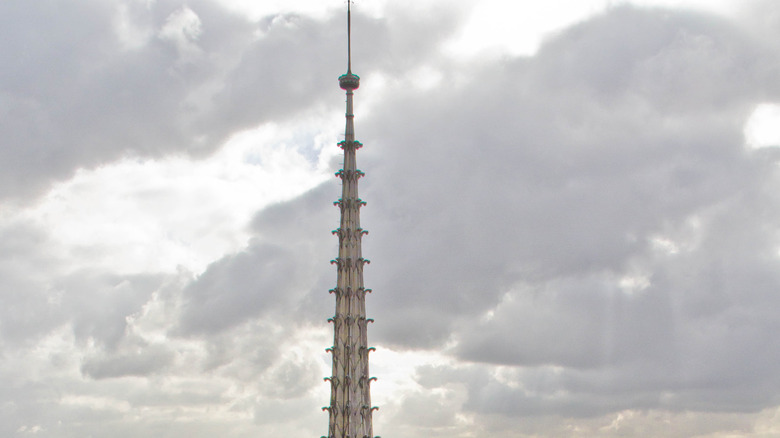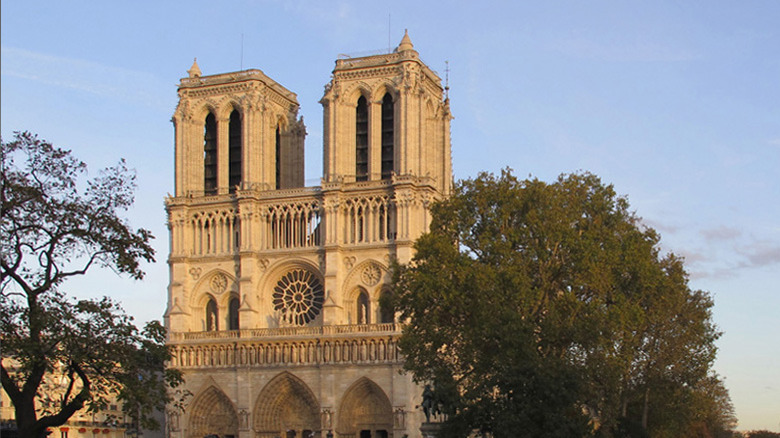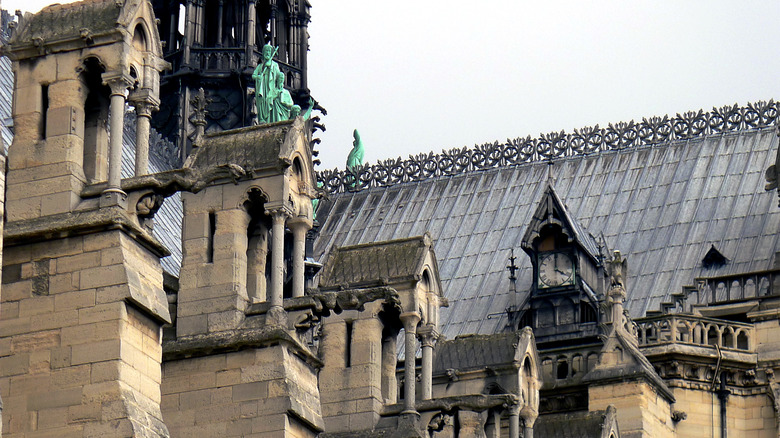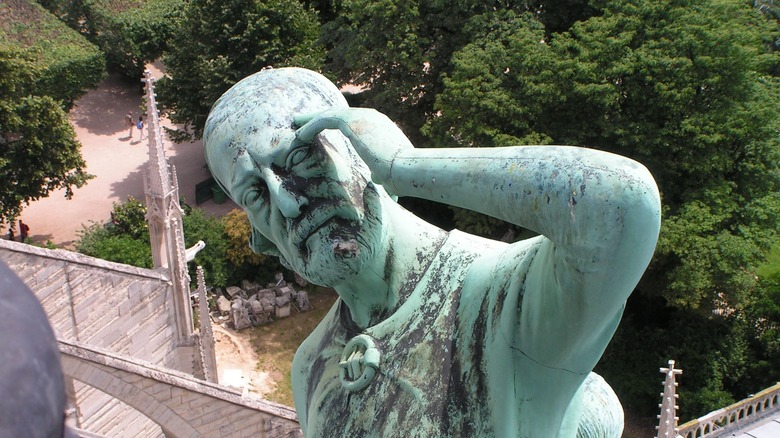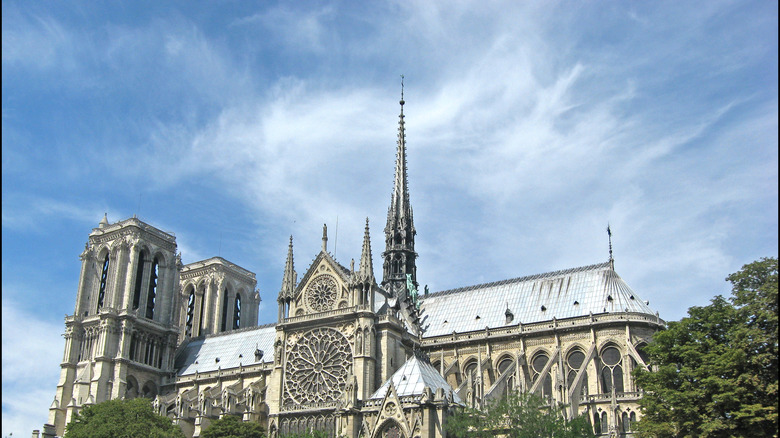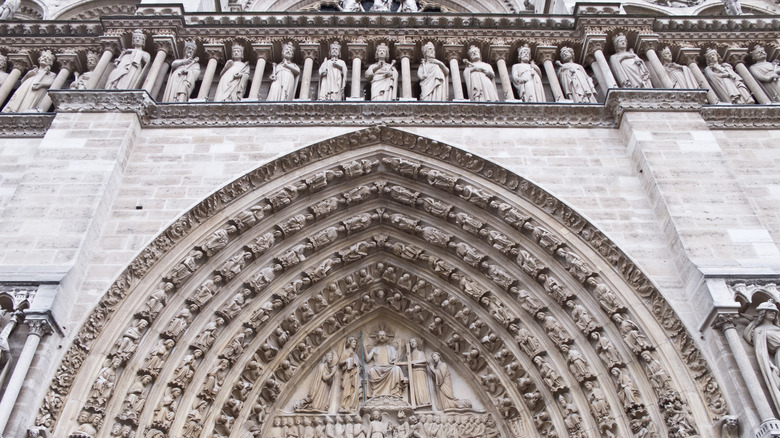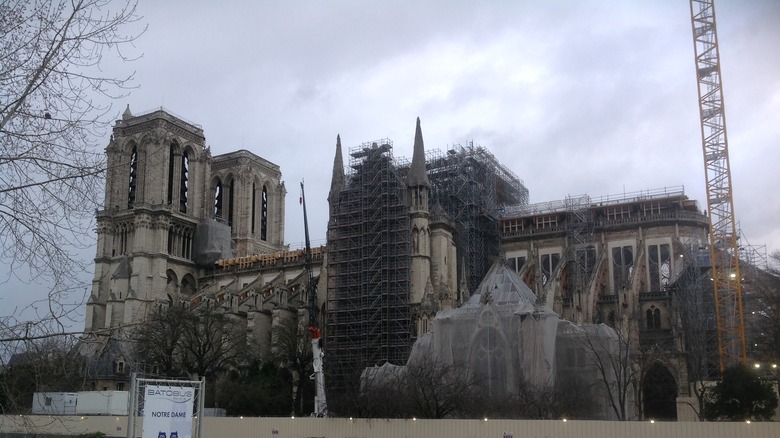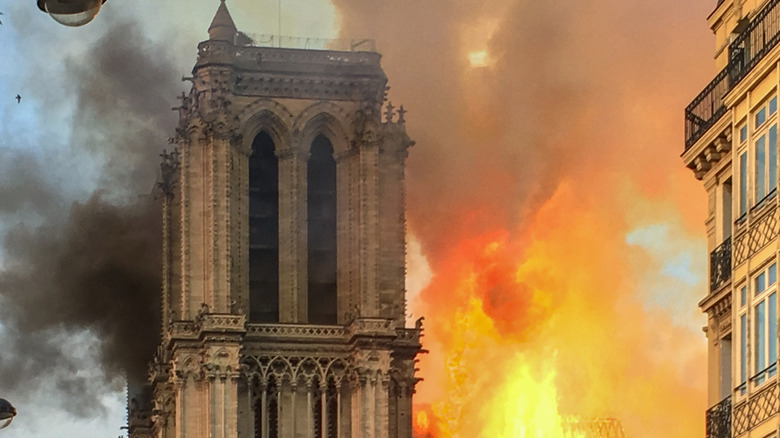The Untold Truth Of Victor Hugo's Hunchback Of Notre-Dame
"The Hunchback of Notre-Dame" is one of two Victor Hugo novels that became extremely famous around the world, the other being "Les Misérables." "Hunchback" was written and published first, in 1831, and is one of the first novels to use a city-wide, sprawling scope instead of an intense focus. The novel is an epic, covering years of history, with the titular cathedral acting as the looming artifact that drives the entire novel, according to SparkNotes. Hugo took two years to actually write the book, since he kept getting distracted by other projects along the way. Once published, it became an instant classic, and helped spearhead a renovation of the Notre-Dame de Paris cathedral, something Hugo had hoped for all along.
The novel's many adaptations struggled to capture the entirety of the story and its themes. Does the Disney version, with its talking poker-playing gargoyles, really capture the foreboding tone of a novel where nearly every named character dies, asks film critic Lindsay Ellis in her video essay "The Case for Disney's The Hunchback of Notre Dame." Each adaptation gained something for whatever else it changed or took away from the original source material.
"The Hunchback of Notre-Dame" succeeded in bringing attention to centuries-old architecture, as well as revitalizing it. Though elements of the novel might be lost in adaptation, Victor Hugo's masterpiece is remembered through the appreciation of the actual Notre-Dame cathedral, which still stands in Paris today.
The Hunchback of Notre-Dame was not Victor Hugo's first work
Victor Hugo was born in 1802. His mother encouraged him to pursue a life of literature. Though he trained in law, he was never a practicing lawyer, writes The Vintage News. Instead, Hugo won several poetry contests as a teenager, and had pieces published in his journal Conservateur Littéraire. Hugo soon began to attempt new styles (mainly romanticism) with the help of a group of young writers who met in his apartment (via Notable Biographies). Romanticism emphasized writing about commoners and their passions, as well as strong emotions in general. Hugo wrote poetry and plays as well as novels, and felt that poems in particular should be a mix of beauty and horror.
Hugo's first novel, published in 1823, was titled "Han d'Islande." At the age of 22, Hugo wrote a volume of poetry which won him a pension from the king, Louis XVIII (via History). In the late 1820s and 1830s Hugo focused on Romanticism and writing plays. He was elected to the Academie Francaise in 1841.
Hugo was involved in politics, and ended up fleeing Paris and living in exile for a number of years due to the French coup in 1851. "Les Misérables" was published in 1862. He returned to Paris in 1870 and continued to write, though his later novels reflected his grief and melancholy, since he had lost his daughter and her husband in a 1843 accident. Hugo had a national funeral in 1885, writes The Vintage News.
The novel was meant to save the cathedral
Victor Hugo originally wrote his second-most famous novel in part to protect Gothic architecture, which was being torn down in favor of more modern styles. A few years prior to writing "The Hunchback of Notre-Dame," Hugo wrote a paper called "War to the Demolishers," which attempted to get across the same point as his later book but was not nearly as popular. The paper discussed the importance of architecture as an art form in and of itself, writes The Vintage News. Gothic art, however, was valued less at the time; the cathedral's stained glass was even replaced in places by plain white glass.
Notre-Dame de Paris, which was built between 1163 and 1345, was meant to symbolize the might of Paris in four aspects: its political, intellectual, economic, and cultural power (via Notre-Dame Cathedral Paris and The Guardian). The cathedral bore witness to Henry VI of England's coronation as the king of France, for example, which he inherited through his grandfather, Charles VI of France.
The cathedral, standing on an island in the middle of the river Seine, was violated by Huguenots in the 16th century, after which it was restored by subsequent French kings. However, Notre-Dame experienced violence again when the French revolutionaries mistook 28 biblical statues for the kings of France and had them all beheaded, according to The Guardian. Hugo wanted to use his novel to bring attention to the cathedral and its rundown state.
The Hunchback of Notre-Dame was plagued by delays
Victor Hugo worked on the novel for two years. He continually postponed his deadlines to his publishers, as during the process he was distracted by other projects. In 1828, despite signing a contract for the novel, he wrote two plays: "Marion de Lorme" and "Hernani." The first was censored due to his risque representation of a courtesan. The second set off a debate between Classicists and Romanticists; by this time, Hugo had firmly centered himself as a Romanticist.
Hugo worked on "The Hunchback of Notre-Dame" for four months straight to finally finish it, writes History. Hugo took extra time to get the details of Notre-Dame de Paris' architecture absolutely correct, according to Quartz. As a Romanticist, Hugo wanted a style that would work with the imperfect and ugly. Quasimodo and his grotesque condition, after all, were a symbol for the forgotten cathedral itself.
The Hunchback of Notre-Dame was enthusiastically received, then and now
"The Hunchback of Notre-Dame" was published in 1831. It proved very popular, and efforts to renovate the cathedral quickly began. According to NPR, readers understood that Quasimodo's story was, in fact, the story of the cathedral as well. People saw it as a deeply human story.
Victor Hugo wanted to write about the spirit of the Middle Ages; he accomplished it by using the cathedral as a set piece. Though the book was instantly popular, writes Notable Biographies, early readers were shocked by Frollo's love for Esmerelda, since as a priest, he had taken holy orders.
The cathedral and the novel have been linked for so many years now that most people's first thought when they saw that the cathedral was on fire in April 2019 was likely of Quasimodo and the bells of Notre-Dame. People attach themselves to narratives. Notre-Dame's cultural history, however, has lived on throughout its times of desecration and rebuilding.
The novel has quite a lot that gets forgotten about in adaptations
Victor Hugo's novel is overrun with minor characters and subplots that got condensed for its adaptations. Said adaptations, as a result, are all somewhat different from one another. For example, for those who've seen the Disney animation adaptation, Frollo is not a judge, but a priest in the book. According to The Mary Sue, Frollo is not immediately a villain in the novel, but finds Quasimodo abandoned by a well and takes the baby in. He also cares for his younger brother Jehan, an indolent university student.
The novel's de facto protagonist is a poet, Pierre Gringoire, who is completely excised in most adaptations. Esmeralda's only defiant action in the novel is to save Gringoire from death by marrying him. Esmeralda is also revealed to actually be French instead of Romani, a casual bit of harmful racism also dropped from most adaptations.
The novel is so broad in scope that screenwriters struggled to fit its entirety into a film's runtime. Hugo also had a tendency to go on tangents about philosophy, the landscape, and history, which are all nebulous topics that are incredibly difficult to pin down on screen. As a result, adaptations focus on the plot, when for Hugo, that was the least important part of his novel, since his focus was more on style, descriptions, and his message.
Title translation mishaps
The title of Victor Hugo's novel in French centered the book fully on the cathedral. He titled it simply "Notre-Dame de Paris," which is the name of the cathedral as well. The English translation, however, centered it on Quasimodo as a character. According to the Pittsburgh Post-Gazette, the title is misleading. Claude Frollo's desires, after all, drive the events of the novel, not Quasimodo's. Frollo desires Esmeralda for his own, and tasks Quasimodo with kidnapping her.
The cathedral is too important an element to avoid focusing on it as the title. Hugo's novel visualizes a historical time period with the cathedral at the center. The cathedral, therefore, becomes a symbol of the novel as well as its historical period. Hugo's style doesn't stick to the plot, either, but jumps around to essays of history, descriptions of the city, and rambles of philosophy. Therefore, the English title is much more heavily focused on the plot than the novel itself is.
The novel encompasses the whole of life
From the king of France to the beggars who live in the streets, "The Hunchback of Notre-Dame" includes everything in its 14th century setting. The cathedral is both a witness and protagonist to the history it is telling. According to Quartz, Victor Hugo dedicated the novel to the cathedral.
"The Hunchback of Notre-Dame" follows a large group of characters, who contrast each other in their occupations, characteristics, and beliefs, writes the Pittsburgh Post-Gazette. Hugo's characters are all well-written; they all have big desires and ideals. Frollo, for example, tries and fails to master his passions over the rational world of science. "The Hunchback of Notre-Dame's" themes include beauty, architecture, love, and learning.
History is a backdrop in the novel, and Hugo's writing style includes reflections, digressions, descriptions, and vocabulary, such as an entire chapter self-descriptively titled: "A Bird's Eye View of Paris." "The Hunchback of Notre-Dame" is an example of the 19th century novel where "philosophy, melodrama, essays on history, and satire all simmered together like leeks and oxtails in a savory pot-au-feu," writes the Pittsburgh Post-Gazette.
The Hunchback of Notre-Dame's influence on architecture
Victor Hugo's book immediately led to demands for a restoration of the cathedral. The architect, Eugene Viollet-le-Duc, was just 30 when he began the project in 1845. He took 25 years to spin the cathedral into a new romantic direction of his choosing. Along with fellow architect Jean-Baptiste-Antoine Lassus, Viollet-le-Duc set about adding ornaments and statues to the cathedral, writes The Guardian. Viollet-le-Duc's iconic spire was made of 500 tons of wood and 250 of lead; it took the place of a previously-unstable tower. The architect surrounded it with fantastical creatures and apostles. Viollet-le-Duc loved medieval Christian monsters and therefore added gargoyles to the cathedral, which later inspired Baudelaire and Rodin (via The Guardian).
However, not everyone was a fan of Viollet-le-Duc's amendments. Critic Ian Nairn wrote of the cathedral in the 1960s, according to The Guardian, calling it: "one of the most pessimistic buildings in the world [with] no hope of change, and no glimmer of ultimate purpose." He later wrote, "Viollet-le-Duc's musty and self-righteous cackle can be heard all over the building."
On the other hand, writers Freud and Proust found the cathedral moving. Proust reportedly once stood in front of it for two hours in only a nightshirt and an overcoat, waiting for inspiration (via Quartz and Mary Bergstein's "In Looking Back One Learns To See: Marcel Proust and Photography").
La Esmerelda: Victor Hugo's...opera adaptation?
Victor Hugo adapted his own novel in 1836, into an opera titled "La Esmerelda." It was ultimately a major failure. Considering it changes the ending significantly, the opera also shows how deviations in future adaptations of the novel began, according to Lindsay Ellis' video essay "The Case for Disney's The Hunchback of Notre Dame."
A family friend and artist in her own right, Louise Bertin, composed the music, writes Opera Today. After refusing an opportunity from another composer, Giacomo Meyerbeer, to adapt "The Hunchback of Notre-Dame," Hugo agreed to write the libretto for Bertin's opera because of their families' friendship, according to Albert Halsall's "Victor Hugo and the Romantic Drama."
The opera debuted at the Académie Royale de Musique in November 1836. It was a flop and closed after six performances. The Catholic censors forbade the word "priest" from being sung in the opera, though some actors forgot during performances (via Halsall's "Victor Hugo and the Romantic Drama"). It is possible that Bertin and Hugo's detractors were another part of the reason the opera failed.
Unlike the Disney version, no one gets a happy ending
In the novel, nearly every character the reader follows dies. According to Sparknotes, Esmeralda is hanged after she refuses to say she's in love with Frollo. Quasimodo, on seeing her dead body, flings Frollo to his death. Even the minor characters die, including Frollo's brother Jehan and Esmeralda's actual mother. Even Quasimodo dies horribly, since he's heavily implied to have starved himself next to Esmeralda's body. (The novel takes a long view of history, providing an epilogue to check in on Esmeralda and Quasimodo years after their deaths.)
Even the characters who do live aren't very good people. The poet, Gringoire, fails to save Esmeralda and runs off with Djali, the goat. Phoebus, a terrible person in the novel, remains a terrible person and marries his fiancée. Even Victor Hugo, who wrote the novel to save a style of architecture, failed. He succeeded instead in promoting the new art form of the novel. On the other hand, the cathedral outlived all these characters, and remains an influence on French culture to this day.
The message of The Hunchback of Notre-Dame may have gotten lost along the way
Victor Hugo's original message was that the new architecture would kill the old. He felt that architecture, a previously great form of communication, was having its last great hey-day before being eclipsed by the printing press (via Quartz). He even lays out his reasoning in the novel (via Online Literature). However, the various adaptations focus much more on the plot and characters than fate and the cathedral as a whole.
French history professor Robert Zaretsky, for the University of Houston, wrote that the history of architecture is the history of writing. From Stonehenge to the Rosetta Stone, alphabets and sentences were written in rows of stone. By Victor Hugo's time, however, architects weren't creating any new styles. Architects instead kept coming back to old ones. Hugo called the French Pantheon, a monument in the Neoclassical style, a "great sponge cake" and famously hated it (via University of Houston). Ironically, he was buried there.
Now, the novel is a great form of communication, with architecture less so. Even if Hugo's original hope did not succeed, the cathedral is still respected and so is his novel.
Sales of The Hunchback of Notre-Dame shot up after the cathedral fire
When the cathedral caught fire on April 15, 2019, sales of the book on Amazon increased. In France, six different editions of the novel were on Amazon's bestseller list (via the Independent), especially seeing as "The Hunchback of Notre-Dame" is a key French work. According to KTLA, other books focused on the cathedral were also on the bestseller list, including a book of art history and a travel guide of Notre-Dame de Paris.
The fire burned for seven hours on April 15 before being extinguished in the evening. The wooden interior and Viollet-le-Duc's famous spire burned, but the façade and towers remain, writes KTLA. Some of the wood in the cathedral's interior had been originally placed in the 1100s. Made of dry oak, it was easy prey for a fire, even an accidental one, according to the EuropeNow Journal. The stone in the uppermost parts of the cathedral experienced the most heat; though stone does not burn, it can crack or break. The loss of the roof also changed the perception of Notre-Dame de Paris, which had been finished off by the clean edges of the lead roof. With the roof gone, the cathedral seemed incomplete. The roof helped extenuate the majestic visual presence of the cathedral (via EuropeNow Journal).
Former Paris mayor Bertrand Delanoë said of the fire, according to The Guardian, "It's an inestimable loss ... Notre-Dame de Paris has to live. We must not resign ourselves to this ... this is the heritage of all humanity."
